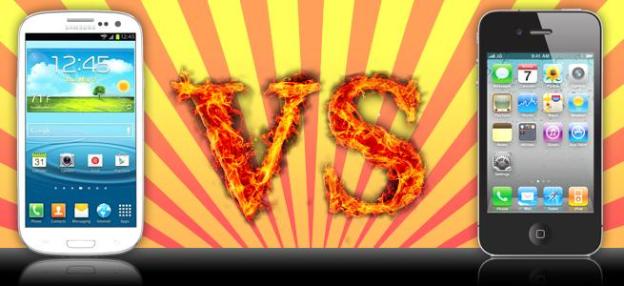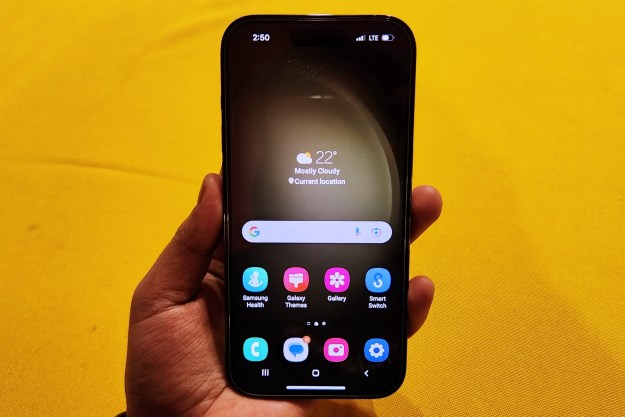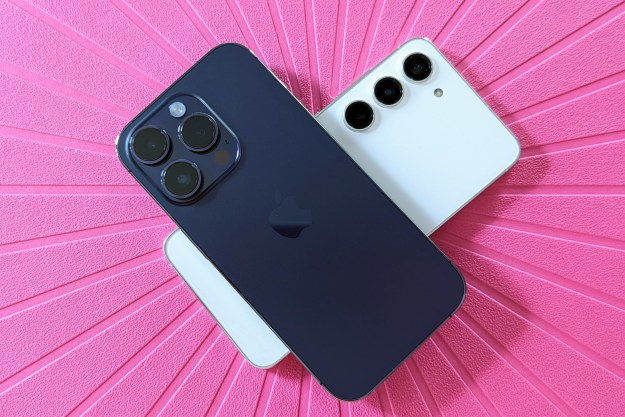
Technology giants Apple and Samsung are duking it out in a California courtroom in what may be the tech trial of the mobile revolution. Did Samsung “slavishly” copy Apple’s patented design and interface elements in products like the Galaxy S smartphones and Galaxy tablets, as Apple claims, or is Samsung merely following broader trends in the mobile industry — trends that weren’t Apple’s inventions at all? Apple might seem to have the upper hand — the case is being tried before the same judge that granted an injunction on sales of Samsung’s Galaxy Tab 10.1 — but trade dress issues are notoriously difficult to win, and patent battles can linger for years.
The trial is on break through August 10, so we thought this might be a good time to look at the major points each side has made so far — and perhaps get a sense of whether Apple or Samsung has the upper hand.
Judge reprimands Samsung

The trial got off to a very shaky start for Samsung. As soon as the jury was selected and opening statements made, Samsung managed to incur the fury of Judge Lucy Koh by leaking material to the media after she had barred it from being presented as evidence during trial. The material concerns Samsung’s F700 smartphone and includes internal email messages that allege Apple’s iPhone designs were based on Sony products. (AllThingsD quickly published the documents.) Although Samsung has repeatedly tried to introduce the material as evidence, Judge Koh has disallowed it due to late submission.
If the jury isn’t going to be hearing that evidence anyway, what’s the big deal if Samsung takes the material public?
Two things. First — and most importantly — the Apple-Samsung jury is not sequestered. Although jurors have been instructed to avoid any mentions or press coverage of the trial, in a media-saturated culture that can be very difficult. Samsung’s statement that accompanied the release also repeatedly referred to the jury — making it clear, at least in Apple’s eyes, who the intended targets of the release were. Second, if something goes awry, and the judge is forced to declare a mistrial, the case could easily wind up in front of another jury — one that has potentially been exposed to Samsung’s inadmissible material.
Samsung maintains the release was ethical and included only information that was already in the public domain. Apple was then forced to do some damage control of its own, releasing iPhone prototype designs that predate Samsung’s F700.
Judge Koh interviewed the jurors, and only one claimed to have seen headlines about the released material. Judge Koh let the trial continue — although it’s important to note she can overrule the jury verdict if she feels they get it wrong.
Apple doesn’t get immediate judgement
Apple tried to immediately leverage Samsung’s release of rejected evidence, claiming Samsung’s actions amounted to misconduct and the correct remedy would be for the judge to grant Apple a summary judgement in the case. Basically, Apple asked the judge to say that given pre-trial evidence and Samsung’s bad behavior, no trial was necessary and Apple wins on all counts. Judge Koh — though clearly displeased with Samsung’s attorney’s — did not grant the request.
Technology press seized on Judge Koh’s rejection of summary judgement as a defeat for Apple, but in reality the whole thing was pro forma — the only thing unusual was Samsung giving Apple some extra ammunition. In virtually every intellectual property case that gets to court, the plaintiff requests a summary judgement before the trial truly gets underway. The defense does essentially the same thing, requesting the case being thrown out because the plaintiff’s case is too weak. On rare occasions — such as when a defendant fails to appear or a plaintiff fails to present relevant evidence of its own — summary judgements might be granted. But in cases with high-profile legal teams, months of pre-trial maneuvering, and and high stakes, there’s no chance for a summary judgement — even with questionable actions from the defense’s legal team. But Apple asked anyway — they had nothing to lose.
Apple prototypes & design process

In what’s got to be an extremely uncomfortable position for Apple, testimony so far has revealed some of the inner workings of Apple’s product design process — including prototype designs for the iPhone and iPad, a few of which date back nearly ten years.
At this point, it’s been well-documented that Apple actually started out working on a tablet device prior to developing the iPhone. Speaking with Walt Mossberg and Kara Swisher at the 2010 All Things D conference, Apple’s Steve Jobs admitted Apple had gotten started on tablet designs with “a multitouch display you could type on with your fingers” long before it thought of making phones. During testimony at the Samsung trial, iOS lead Scott Forstall revealed that Apple’s own dislike with the mobile phones they were carrying around at the time led them to adapt technology they’d already been working on for a tablet and apply it to a smartphone.
But the material Apple has submitted into evidence at the trial is an unprecedented disclosure for the company, which is famously secretive and keeps its product development plans very close to its vest. Testimony from Forstall confirms that the iPhone team was kept segregated from the rest of Apple for years in a cloaked environment that was unusual even by Apple’s standards. Furthermore, designer Chris Stringer — called as Apple’s first witness — revealed that Apple’s products are typically designed by groups of just 15 or 16 people, who often literally meet around a kitchen table to hash out even the tiniest details of product design. They work on sketches, then break up to produce CAD models and, if ideas look good, physical models.
“There could be 50 designs for a single button,” Stringer said. “We’re a pretty maniacal group of people.”
Samsung’s “crisis of design”
It’s no surprise that Apple sinks considerable talent and resources into designing its products — but that doesn’t necessarily have much direct bearing on Samsung’s products, unless Apple can successfully assert that Samsung knowingly copied those products. And Samsung’s legal team may have provided Apple an opening, via a slip of the tongue that has allowed Apple to introduce new material into evidence.

Apple had begun presenting its case that Samsung had mimicked the iPhone’s icon designs. During Samsung’s response, attorney John Quinn — the same lawyer responsible for releasing the F700 information to the press — mentioned a Samsung memo that referred to a “crisis of design” at Samsung. And with that, the memo came into evidence. Until that point, Samsung had managed to keep it out.
Apple is almost certain to refer to the memo as the case proceeds — because it’s a doozy (pdf). Written in 2010 by Samsung’s mobile chief J.K. Shin, the memo extolls the first-generation iPhone interface, describing the difference between the iPhone and Samsung’s then-current Omnia phones as the difference between “Heaven and Earth.”
“All this time we’ve been paying all our attention to Nokia,” Shin wrote in the memo. “Yet when our UX is compared to the unexpected competitor Apple’s iPhone, the difference is truly that of Heaven and Earth. It’s a crisis of design.”
Apple maintains that, in the wake of Shin’s memo, Samsung’s phone products quickly began to bear an even stronger resemblance to the iPhone.

Shin wasn’t the only person at Samsung comparing the iPhone to the company’s products. All Things D has published a copy of a 132-page document that rolls through features of the original Samsung Galaxy S phone, comparing them to the iPhone — and the Samsung device does not fare well. The report concludes that the Galaxy phone would be better if its interface and behavior were more similar to the iPhone, potentially adding considerable weight to Apple’s claims that Samsung outright copied the iPhone. The document even says the Samsung phone gives a “strong impression that the iPhone’s icon concept was copied.”
Samsung maintains that it benchmarks its devices against competitors’ products all the time, and the memo has no particular significance.
Did Samsung’s tablets confuse consumers?

Apple has maintained that the visual similarity between Samsung’s Galaxy Tab 10.1 and the Apple iPad was confusing to consumers, with suggestions that consumers had been returning Samsung tablets to retailers because they thought they were buying an iPad. However, Samsung entered a study into evidence that purported to show that the primary reason customers were returning Samsung’s Galaxy Tab 10.1 to Best Buy stores in 2011 was — get this — that the devices just didn’t work. According to the study, 25 percent of consumers returning Samsung’s tablets cited browser freezes, poor screen sensitivity, and poor Wi-Fi connectivity as reasons for their return; another 17 percent cited screen lag, sync problems, and poor battery life. Only 9 percent were exchanges for the then-current iPad 2.
Apple pointed out that, among consumers who said they didn’t have sufficient knowledge of the products, the single greatest reason for returns was that they thought they were buying an iPad. Samsung retaliated by noting that Apple’s own experts can’t agree that any brand dilution that may have occurred means Apple’s iPad sales were harmed in any way. To win an infringement case, Apple will have to prove it’s business was harmed as a result of marketplace confusion.
But is it actually infringement?

Glancing over all the material Apple has presented at trial so far, it’s easy to assume Apple has the upper hand. After all, there is an uncanny physical and on-screen resemblance between Samsung’s Galaxy S devices and Apple’s iPhone — and the same is true for Samsung’s Galaxy Tab products and the Apple iPad. That sense can also be swayed by some of Samsung’s trial tactics: in addition to releasing material to the media, the jury will get to hear that Samsung allowed relevant evidence to be destroyed (and they may presume that evidence would have been in Apple’s favor). Samsung also managed to annoy Judge Koh by giving five witnesses a private showing of the courtroom. (Samsung attorney Christopher Stretch claimed that witnesses from the Netherlands and South Korea had never seen a U.S. District Courthouse, so he brought them by, asked court personnel to unlock the courtroom, and gave them a tour. Stretch — presumably an experienced attorney — claimed he was unaware of any rule against visiting the courtroom when court was not in session.) Judge Koh has also threatened to sanction Samsung attorney John Quinn.
But opinion doesn’t matter. Apple needs to prove Samsung’s products violate its patents, and the legal threshold for patent infringement can be notoriously squirrelly. For instance, one of Apple’s patents in the case concerns adjusting the scrolling speed on a touchscreen device in response to finger movement: move slow, the content scrolls slowly; move fast, the content scrolls faster. (The patent also covers scaling and rotation on a touchscreen display.) Apple claims Samsung violates Apple’s patent on the idea; Samsung, of course, is likely to argue the functionality is obvious and does not deserve patent protection.
High stakes
For Apple, the stakes are far higher than the $2.5 billion the company is seeking in damages. What’s really at issue is whether Apple can prevent Samsung — and potentially a myriad of other companies — from copying significant elements of its product design.
Apple has been down this road before — several times. Back in the 1980s — yes, the 1980s — Apple sued Microsoft for the obvious: copying crucial elements of the Macintosh graphical interface in Windows. The case dragged on for four years and Apple lost. (Elements lingered until the late 1990s and Steve Jobs’ return to Apple. Remember when Microsoft allegedly “saved” Apple in 1997 by buying $150 million in stock? That was the end of it.) Part of the reason Apple lost that case was that key elements came down to contract law rather than copyright law. And even though Steve Jobs wasn’t at the company’s helm at the time, it’s fair to say the company was…displeased.
Fast forward to the 2000s: everyone knows Apple revolutionized the portable media player business with the iPod, right? Yup. But they also got nailed on patents, with Creative Technology walking away with a $100 million settlement for its “Zen” patent covering organization and navigation of music tracks on a portable device.
By that point, Apple was already working on early version of the iPad and the iPhone, and the company learned its lesson. Patent everything. The patent system may be a mess, but it’s the only viable legal option companies like Apple have for protecting their intellectual property — particularly if they’re not interested in licensing their technology to other companies.
As a result, the iPhone and iPad represent Apple’s most patent-protected products to date. Apple’s claims that the iPhone “changed everything” might be a bit of hyperbole, but it’s no exaggeration that the entire mobile industry was blindsided by the impact of the iPhone. And after five years, in many ways, it still trying to respond — Apple remains in the driver’s seat.
If, after all the effort, time, and resources Apple has invested, the company cannot protect the iPhone and the iPad from imitators, it proves two things:
- The patent system offers little protection for innovations;
- Apple is effectively the research and development division for an entire industry.
The Apple-Samsung trial resumes August 10.
Editors' Recommendations
- Everything you need to know about the massive Apple App Store outage
- iPhone Flip: what we know about Apple’s first foldable phone
- The OnePlus 12 has one big advantage over Samsung and Apple
- Samsung Galaxy S24 vs. iPhone 15: don’t buy the wrong one
- iPhone 15 Pro Max vs. Samsung Galaxy S23 Ultra: which one is best?


